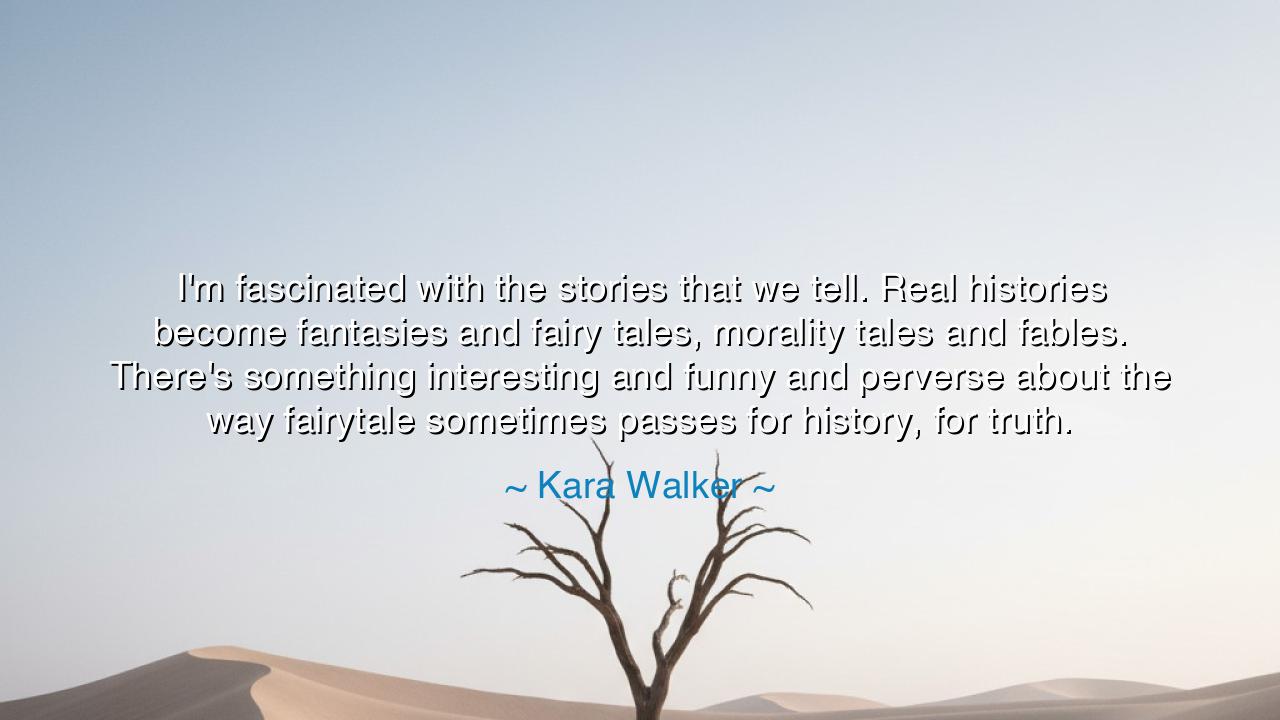
I'm fascinated with the stories that we tell. Real histories
I'm fascinated with the stories that we tell. Real histories become fantasies and fairy tales, morality tales and fables. There's something interesting and funny and perverse about the way fairytale sometimes passes for history, for truth.






The words of Kara Walker—“I’m fascinated with the stories that we tell. Real histories become fantasies and fairy tales, morality tales and fables. There’s something interesting and funny and perverse about the way fairytale sometimes passes for history, for truth.”—speak to the eternal tension between truth and storytelling, between memory and myth. Beneath her reflection lies an ancient and unsettling wisdom: that humanity does not remember its past as it was, but as it wishes it to be. Through the centuries, we have reshaped history into legend and legend into comfort, polishing pain into beauty, guilt into glory. Walker, whose art exposes the haunting legacy of race, violence, and identity in America, reminds us that truth, when retold too often, becomes fiction—and fiction, when repeated long enough, begins to feel like truth.
To say that “real histories become fantasies” is to acknowledge the power—and danger—of narrative. Every people, every nation, dresses its past in symbols. The victors carve their stories into monuments; the vanquished whisper theirs into songs. Over time, what was once fact dissolves into interpretation. The agony of injustice becomes a “lesson,” the cruelty of oppression becomes “heritage,” and the blood of victims becomes “sacrifice.” In this transformation, Walker finds both fascination and unease. She sees how the human desire to simplify and moralize can turn the horrors of the past into tales that soothe rather than awaken. And yet, in that very distortion lies a strange truth about the soul: we cannot live without stories, even when they betray us.
This phenomenon is as old as civilization itself. The ancients too turned their histories into myth. The city of Troy, which fell to greed and vengeance, was immortalized as a tale of gods and heroes. The Romans, who conquered nations, told themselves they were spreading order and civilization. The violence of empire became divine destiny, and the suffering of others vanished in the poetry of victory. So it is in every age: we replace the raw truth of our deeds with narratives that justify, exalt, or amuse us. This, Walker observes, is both “funny” and “perverse”—for even as we distort history, we believe we are preserving it.
In her art, Walker exposes this paradox through images both beautiful and brutal. Her silhouettes—elegant in form yet horrific in content—mirror the way society itself cloaks atrocity in elegance. She takes the fairy tale of American history—the illusion of purity and progress—and peels it back to reveal the grotesque truths it hides. In her hands, the fantasy collapses, and the fable turns against itself. Like the prophets of old, she wields irony and darkness not to destroy, but to awaken. For she understands that truth cannot be taught gently—it must disturb, provoke, and unsettle the slumbering conscience.
Her observation that fairy tale “sometimes passes for history” is a warning to all who inherit stories without questioning them. When we accept the narratives given to us by the powerful, we become part of the illusion. Every myth of purity hides a crime; every fable of heroism conceals a victim. Yet Walker’s tone is not despairing—it is curious, even wry. She sees the comedy in our self-deception, the absurdity of humans who, generation after generation, believe their myths are unique when they are only repeating the same patterns. There is, she says, something “funny and perverse” about this eternal masquerade—a dark humour in how easily we trade truth for comfort.
The story of Christopher Columbus, for example, shows how history can become myth. For centuries, he was celebrated as a brave explorer who “discovered” a new world—a tale told in classrooms as a triumph of courage and vision. But behind that fable lies the reality of conquest, enslavement, and genocide. The fairy tale of discovery became the foundation of a national identity, while the truth was silenced. In recent decades, that myth has begun to unravel, and we are left to confront the uncomfortable question: How many of our heroes are built on half-truths and erasures? Walker’s insight reminds us that such revelations are not new—they are the recurring work of each generation, to strip away illusion and restore truth to the light.
From her reflection, we draw a lesson both timeless and urgent: beware of the comfort of stories. It is easy to believe the version of history that flatters us, to repeat the myths that make us feel righteous. But if we wish to live honestly, we must question the tales we are told—and those we tell ourselves. Seek the truth beneath the legend, the humanity behind the symbol. Let art, literature, and conversation become tools not for escape, but for revelation. The truth may wound, but in that wounding there is cleansing, and from cleansing, renewal.
So, my friends, remember this: every story has power, and every retelling is an act of creation. Do not fear the uncomfortable truths that art or history may uncover. They are the medicine of the soul, the teachers of compassion. Learn to laugh, as Walker does, at the absurdity of our myths—but also to grieve what they conceal. For when you look deeply enough into the fairy tales of history, you do not find heroes or monsters—you find yourselves. And it is in that mirror of truth, both terrible and tender, that wisdom is born.






AAdministratorAdministrator
Welcome, honored guests. Please leave a comment, we will respond soon